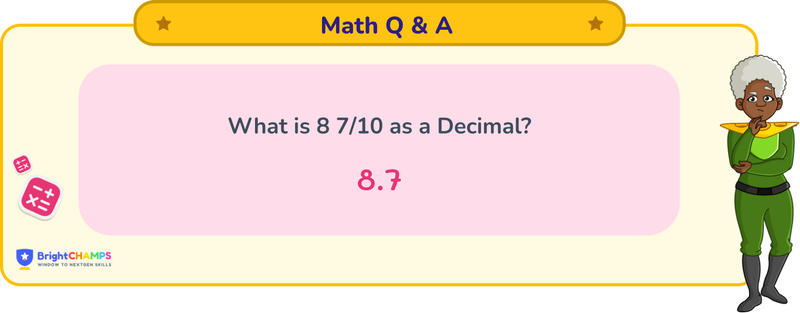Summarize this article:
 228 Learners
228 LearnersLast updated on August 5, 2025
8 7/10 as a Decimal

It is a simple question on decimal conversion. Firstly, we have to learn fractions and decimals. A fraction represents a part from the whole. It has two parts, the numerator (number on the top) here, 7 represents how many parts out of the whole. The denominator (number below) shows how many parts make the whole, here it is 10. A decimal is a way to represent the number that is not whole, using a (.) or a decimal to separate the whole part from the fraction part. The numbers to the left of the decimal point represent the whole, and those to the right represent the fractional part.

What is 8 7/10 as a decimal?

Answer
8 7/10 in decimals can be written as 8.7. This is a terminating decimal, as it ends after one decimal place.
Explanation
To convert 8 7/10 into a decimal, we will use the division method for the fractional part. Here, 7 is smaller than 10, so we can directly convert it using decimals. Let's see the step-by-step breakdown of the process:
Step 1: Identify the whole number and the fractional part. The whole number is 8.
Step 2: For the fraction 7/10, recognize that 10 is a power of 10, which makes it straightforward to convert.
Step 3: Divide the numerator (7) by the denominator (10). This division gives us 0.7.
Step 4: Combine the whole number with the decimal part. The whole number is 8, and the decimal part is 0.7.
Step 5: The final result is 8.7, where 8 is the whole number and 0.7 is the decimal representation of the fraction.

Important Glossaries for 8 7/10 as a decimal
- Fraction: A numerical quantity that is not a whole number, representing a part of a whole.
- Decimal: A number that uses the base ten and includes a decimal point to separate the whole part from the fractional part.
- Numerator: The top part of a fraction, indicating how many parts of the whole are being considered.
- Denominator: The bottom part of a fraction, showing how many parts make up a whole.
- Terminating Decimal: A decimal that ends and does not repeat infinitely, such as 0.7.




